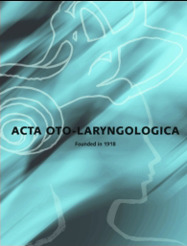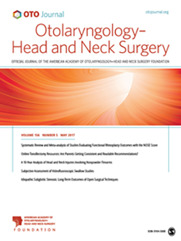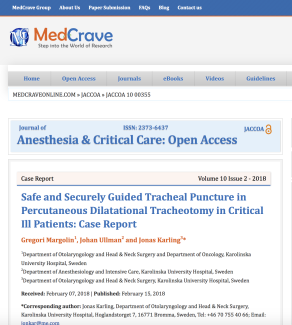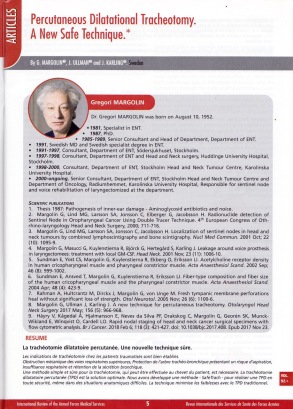PUBLICATIONS

A new safe and cost-effective percutaneous dilatational tracheotomy - SafeTrach
(ACTA OTO-LARYNGOLOGICA, 2016
http://dx.doi.org/10.3109/00016489.2016.1139746)
Link to full text of the article:
http://www.tandfonline.com/eprint/q2acjdPv72Z8cPGggjXB/ful
ABSTRACT
Conclusion: SafeTrach is a new simplified and safe technique to perform percutaneous dilatational tracheotomy (PDT) that eliminates known risk factors compared with existing percutaneous techniques. In the present clinical study, also patients with disadvantageous anatomy not suitable for conventional PDT (CPDT) were treated without complications using SafeTrach. PDT with SafeTrach (STPDT) offers an excellent solution for patients who need tracheotomy in connection with elective ear- nose- and throat (ENT) surgery.
Objectives: To asses a new technique for percutaneous tracheotomy. Methods: Seventeen patients were tracheotomized with STPDT using SafeTrach for the initial penetration sequence and single step dilatational techniques for the dilatational sequence. The patients represented a variety of different neck anatomies. Fifteen patients were head- and neck cancer patients that were subjects of free flap transplants.
Results: This study showed that STPDT was safe and easy to perform and time-efficient. The median duration of the procedure was 11,5 minutes and the puncture was in all cases located in the midline of the trachea either between the 2nd and 3rd tracheal ring (n=13) or between the 3rd and 4th ring (n=4).
Keywords: Tracheotomy, tracheostomy, percutaneous, tracheostoma, intensive care, head and neck tumors, head and neck surgery, upper airway obstruction.

A new technique for
percutaneous tracheotomy
(Otolaryngology–Head and Neck Surgery 1-3, March 2017)
https://us.sagepub.com/en-us/nam/journals-permissions
ABSTRACT
The objective of this study was to investigate a new technique for tracheal puncture during percutaneous dilatational tracheotomy (PDT). A new invention, known as SafeTrach, was used: this is an instrument, which allows exact localization of the puncture site with built in protection of the posterior tracheal wall. Surgery was performed on seventeen patients with this technique and our experience is described in this report. The results showed that this new technique minimizes known risk factors compared to existing PDT techniques including patients with disadvantageous anatomy.
Keywords: Tracheotomy, tracheostomy, percutaneous, tracheostoma, intensive care, head and neck tumors, head and neck surgery, upper airway obstruction.

ABSTRACT
This article reports on 2 cases of critical ill patients in need of tracheotomy. Both patients were subjects to percutaneous dilatational tracheotomy but had a difficult neck anatomy and hence difficult to find the proper puncture site that should be between the 2nd and 3rd or 3rd and 4th tracheal rings. To make it possible, the punctures were guided with the help of a new device – SafeTrach. This device has an inner and an outer shank that functions like a tweezers. When the inner shank is in place inside the orotracheal tube and the outer shank is connected to the inner shank, the puncture needle in the tip of the outer shank is pointing against the tip of the inner shank inside the trachea. This part of the inner shank is protruding from the tube, ensuring that the puncture will not be made in the tube or in the posterior wall of the trachea and in a proper angle. In both cases the procedures were successful and made in less than 10 minutes.
Keywords: Tracheotomy; Tracheostomy; Percutaneous; Dilatation; Tracheostoma; Intensive care
Safe and Securely Guided Tracheal Puncture in Percutaneous Dilatational Tracheotomy in Critical Ill Patients: Case Report
(MEDCRAVEONLINE.COM » JACCOA » JACCOA 10 00355,
February 2018)
http://medcraveonline.com/JACCOA/JACCOA-10-00355.php

ABSTRACT
Indications for tracheotomy of trauma patients are well established.
Mechanical upper airway obstruction, Protection of trachea-bronchial tree at risk of aspiration, Respiratory failure and retention of bronchial secretion. A simple and safe method for tracheotomy, which can be performed bedside, is necessary. Percutaneous dilatational tracheotomy (PDT) is the optimal solution. We have developed a method - SafeTrach - to do safe PDT even in difficult anatomical situations. The technique minimizes the weaknesses with traditional PDT: s. SafeTrach has a pliers-like design for safe determination of the level of tracheotomy that leads a puncturing needle against, and with the protection of, an internal shank. The relation between the inner shank and the endotracheal tube gives a dear measure of how deep below the vocal cords the site for the punctuation is. The inner shank will always stay in the center of trachea why the puncture through the outer shaft guarantees a puncture in the midline.
Keywords: Tracheotomy, Tracheostomy, Medical device, Bedside, Percutaneous
Percutaneous Dilatational Tracheotomy. A New Safe Technique
International Review of the Armed Forces Medical services.
December 2019; Vol 92/4 (5-8)

ABSTRACT
Introduction. Patients with head and neck tumors an are often require tracheostomy. This procedure represents complex surgical manipulation and is associated with risk of certain complications, including life-threatening.
The study objective is to assess the results of percutaneous tracheostomy with the new SafeTrach technique.
Results. Mean duration of tracheostomy with SafeTrach technique was 11.8 +/- 3.4 minutes independently of body mass index or previous treatment (correlation coefficients r = 0.08, p = 0.7 and r = 0.08, p = 0.73 respectively). Among all possible complications of tracheostomy only 1 (r4.7 %) case of bleeding in postoperative period was noted in our study.
Conclusion. The SafeTrach technique combines all the benefits of open and percutaneous tracheostomy. It is characterized by simplicity, it does not require endoscopic control that indicates the feasibility of its widespread implementation.
Keywords: head and neck tumors, malignancies, percutaneous tracheostomy, open tracheostomy, SafeTrach technique, complications, upper airway obstruction
Alymov Yu.V., Mudunov A.M., Podvyaznikov S.O., Margolin G.
Percutaneous dilatational tracheostomy in patients with head and neck tumors: literature review and institutional experience
Opukholi golovy I shei = Head and Neck Tumors 2020;10(1):47-54.
(in Russian)
Yu. K Alymov1, A.М. Mudunov1, S.0. Podvyaznikov2, G. Margolin3
1N.N. Blokhin National Medical Research Center of Oncology, Ministry of Health of Russia; 24 Kashirskoe Shosse, Moscow 115478, Russia
2Russian Medical Academy of Continuing Professional Education, Ministry of Health of Russia; Bld. 1, 2/1 Barrikadnaya St.,
Moscow 125993, Russia;
3Karolinska University Hospital, Karolinsks Institute; SE-171 77 Stockholm, Sweden

Navigation system for percutaneous tracheotomy
(2021 Oct;141(10):953-959.
doi: 10.1080/00016489.2021.1982147.Epub 2021 Sep 27.)
Link to full text of the article:
https://pubmed.ncbi.nlm.nih.gov/34570658/
ABSTRACT
Background: Percutaneous dilatational tracheotomy (PDT) is a well-established method. The prerequisite is to identify anatomical landmarks of the neck. We introduce a three-dimensional navigation system - SafeTrach.
Aims/objectives: We present an alternative technique using internal landmarks that can be used in patients with difficult anatomy.
Material and methods: The device is a forceps-like instrument with an outer and an inner shank. The later serves as a ventilation lumen and stabilizes the orotracheal tube in the midline of trachea. The outer shank acts as a three-dimensional guide for the puncturing needle.
Results: Out of 48 patients we have determined the level of puncture in 20 patients by using intraoperative measurements. The distance from the vocal cords to the puncture site was about 50 mm for men and 40 mm for women. In 13 of the patients who had had CT scans, we studied the distance between the vocal cords and the optimal puncture site and found the median distance for men 45 mm and for women 42 mm.
Conclusions and significance: With the studied navigation system one may use external or internal landmarks to indicate the puncture level in PDT. The device may minimize the risk of injuring the posterior tracheal wall.
Keywords: Tracheotomy; dilatational; percutaneous; tracheostomy.